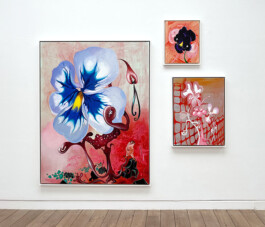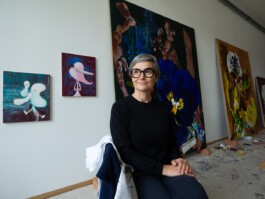
SUSANNE KÜHN - interview with Beck & Eggeling
There is a tendency towards more floral motifs in your latest works. These are invented, rather hybrid plants. How do you come up with these motifs and what does nature mean to you?
Everything that thrives and can be observed excites me and drives a huge curiosity in me. I always want to know exactly how something works: whether it is the growing of plants, the way a machine works or the construction of a house. I have had a great enthusiasm for plants since childhood. I collected plants and seeds, tried to grow flowers, was keen on colourful little flowers like the ‘Gamander speedwell’ (incidentally also called “Männertreu or Frauenbiss” !), which did not grow excessively in Saxony at the time. In addition, I created herbaria with a flower press built by my father, and besides, biology was my favourite subject at school. In my paintings, I was initially interested in the threshold between urban and natural habitats.
Surrounded by these heterogeneous places, I often portrayed women who generated meaning and sometimes acted like a catalyst. In my most recent series of paintings, I have started to give plants a humanoid appearance, more or less changing the phenotype and modelling vivid characters out of inconspicuous plants.
At the moment, I am in the process of taking a closer look at herbaria. Recently, I came across a herbarium of marine plants in the ‘Central Art Depot’ of the Freiburg museums. It was spontaneously the only historical herbarium associated with the name of a woman, even if it was probably not created by her. I am looking for dissonances and inconsistencies in the perception of our natural and artificial habitat. It is in this mental haze that I have arrived at my very recent motifs: a portrait series of pansies on the seabed.
Compared to earlier pictures, we no longer see any architecture and, above all, no people. Yet you are very much concerned with people and their abilities. What role do people play in your painting?
With your question you open up a complicated field, because in everything that is created on the canvas there is a direct or indirect reference to man. Above all, in representational painting, we often expect that the depiction of the human being inevitably also means that the painting speaks exclusively about the person depicted. I have actually thought about this many times and have come to the conclusion that my interest in people is particularly rooted in their role for painting. By role for painting, I mean the action of the women depicted in my paintings in relation to the present moment, their relationship to their surroundings (including architecture) and to selected (art-)historical references. I believe that this approach is a pattern that leads to the development of new pictorial ideas—with or without people. Furthermore, I think that the plants I am painting need to be the focus of the play in order to unfold their full energy. They are superstars that take up all the space; therefore, there is no need for other elaborate or referential subjects that would only end up being distracting. So my pictures still accommodate both: they are artistically constructed and tell of human actions.
Furthermore, I think that the plants I am painting need to be the focus of the show in order to unfold their full energy. They are superstars that take up the whole room; therefore, there is no need for other elaborate or referential subjects that would only end up being distracting. So my paintings still accommodate both: they are artistically constructed and tell of people's actions.
You are a professor of free painting at the Academy of Fine Arts Nuremberg. How is the work at the Academy ?
The work in my class is really great—we deal with painting pure and expanded, analogue and digital, historical and contemporary. Not only is the Academie a beautiful place—the Sep Ruf-campus is unique and I recently heard that the atmosphere is like that of a sanatorium.
At the moment, I am developing a project with my class that focuses on drawing as an analogue and communicative tool. We are drawing together; learning the Chinese rubbing technique and discussing the potential of such a fundamental medium in today’s world in relation to painting. ZeichenTRICK will soon be shown at the Museum für Neue Kunst Freiburg on the occasion of the anniversary of the Förderverein. For the opening and a workshop of my students with the museum visitors, the whole class travels to Freiburg by train, while the entire exhibition fits into an envelope.
It is very fulfilling to be able to work with young people, to impart knowledge and experience to them and to formulate ideas together. I am particularly happy that the work in the study studios - especially painting - is literally exploding after the difficult years of the pandemic.
And in turn, what does your painting practice look like?
As with previous series, I am developing many canvases at the same time for ‘Pansies’. At the moment there are five large canvases and a handful of small panels. Already during the imprimatur—the first layer of paint after priming —I pick up the colour mood I recognise in the blossoms: rich dark tones like bordeaux or chrome oxide green fiery, shimmering like velvet in the evening light. The blossoms thus stand equal in a sound space and can unfold their character and strangeness in different ways. When I work on new paintings, I am constantly in the studio working away at my counterpart. It is a constant adding, questioning and overpainting —not on the individual painting—but out of the dialogue that develops between the group of paintings and me.
You lived in New York and Boston for a long time, but now you have been living in Freiburg im Breisgau for almost 20 years. What do you appreciate about the region of the southern Black Forest and what do you miss about America or other metropolises?
When we moved from New York to Boston many years ago, I was always homesick for New York. When we came back to Germany from Boston, I missed the US. In the meantime, we have been in Freiburg for a long time, but my everyday life is so varied, intense and sometimes stressful that the question of where to live is rather secondary. I am constantly traveling to see new exhibition venues, meet people, visit exhibitions and, after all, I live part-time in Nuremberg to teach at the Academy. So it never gets boring.
What's more, my studio is on the edge of a small town on the Elz, a river that likes to make big waves when it rains up in the Black Forest. From the studio window I can see cows on the steep meadows and a magnificent row of trees on the horizon. On the way back from the studio to Freiburg, the whole panorama of the Rhine plain spreads out before me, with the Kaiserstuhl and the Vosges - not to mention the fantastic food and wine. Freiburg is undoubtedly not a metropolis, but you can't have it all.

Susanne Kühn, Studio visit July 2023, photo: Xaver Kühn
Susanne Kühn © 2024 and VGBildkunst Bonn. privacy policy contact